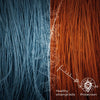
Thermal Damage – What Heat Really Does to Your Hair
3 min reading time

3 min reading time
Learn how heat microscopically affects hair . Discover what thermal damage does to the structure and how professionals can safely protect hair.
Thermal Damage Under the Microscope – What Heat Really Does
Heat is the silent enemy of healthy hair. Blow-drying, straightening, or curling may seem harmless, but at a microscopic level, it fundamentally alters the hair's structure. For a professional, understanding thermal damage is essential – it makes the difference between temporary styling and structural weakening.
1. What happens to hair when heated?
On average, hair contains 15% water in the cortex. When we apply heat (above 150°C), this moisture evaporates rapidly.
✔ The cuticle dries out and loses flexibility.
✔ The disulfide bonds in the cortex are weakened.
✔ The protein structure (keratin) begins to denature – just like protein solidifies when heated.
From 200°C onwards, bonds are irreparably broken – the hair loses bounce and shine.
2. What do we see under the microscope?
Under the microscope, thermally damaged hair shows clear patterns:
✔ Bloated, cracked cuticle cells.
✔ Superficial cracks due to dehydration.
✔ Burned or deformed cortex fibers.
✔ Dark spots – charred proteins.
The result is structural hardening – the hair feels rough, brittle and uneven.
3. Temperature and Time – The Law of Damage
The intensity of damage depends on temperature × duration .
✔ 150°C – water evaporates, cuticle loses flexibility.
✔ 180°C – keratin bonds begin to break.
✔ 200°C – permanent damage to the cortex.
✔ 230°C – combustion and keratin carbonization.
Even a short exposure of 2–3 seconds to 230°C can cause microcracks.
4. Styling without damage – the scientific approach
✔ Always work with heat protectants – silicones or polymers that form a thin film.
✔ Keep the device moving – never leave it in one place for too long.
✔ Use temperature control – 160–180°C is safe for healthy hair.
✔ After styling, finish with a pH-balancing spray to close the cuticle.
✔ Apply a hydrating or protein-rich mask 1–2 times a week.
5. Repair of thermally damaged hair
Thermal damage is not fully reversible, but can be stabilized .
✔ Amino acids (such as cysteine) strengthen remaining bonds.
✔ Keratin and collagen fill micro-gaps in the cortex.
✔ Lipids and oils restore the protective film around the cuticle.
✔ Hair Botox and Plex treatments help to “glue” broken bonds.
6. Prevention: customer education
Most damage is caused by lack of knowledge, not by heat itself.
✔ Teach customers the difference between “oil shine” and “structure shine”.
✔ Recommend styling tools with ionic technology or ceramic plates .
✔ Explain why daily styling without protection makes hair irreparable.
Education is the most powerful form of protection.
Conclusion: heat is not the problem – misunderstanding is
Thermal styling can be safe if you understand how heat works. By applying scientific knowledge, we protect hair at the molecular level. Because true craftsmanship isn't just about styling, it's about understanding what happens under the microscope .